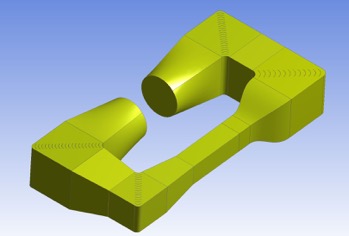11 Dec 2017
10 Nov 2017
Commissioning a wind tunnel for aerodynamic testing
In order to equip itself with the most modern technology and to become a reference center among educational institutions in the area of racing cars’ engineering, a new center that will open its doors in 2018 has hired KeelWit to design and manufacture its wind tunnel for aerodynamic testing. Once the specifications list of the device has been agreed, KeelWit is applying its MOST-HDS algorithm to optimize its design while respecting the available footprint in the room where it will be installed, as well as the speed indexes that are required for accurate...17 Oct 2017
KeelWit article in the scientific magazine DYNA on CFD optimization of boilers for combined cycles
KeelWit has published an article titled Boiler inlet duct shape design optimization for combined cycle power plants. Founded in 1926, DYNA is one of the most influential and prestigious engineering journals in the world, as recognized by Thomson-Reuters in the annual edition of its JCR report and undoubtedly a reference of scientific publications in Spanish. The contribution of this paper is twofold: on the one hand, it shows that there is substantial room for improvement in the shape design of the inlet ducts of Heat Recovery Steam Generators (HRSGs), in terms of achieving a lower pressure drop, a higher velocity uniformity and an important cost reduction of the unit; on the other hand, it shows how the application of the Multi Objective Structured Hybrid Direct Search (MOST-HDS) algorithm, can find improved designs. This algorithm is applicable in many fields for aerodynamic shape optimization involving big displacements, which can be quite unconventional and non-intuitive. The MOST-HDS algorithm combines genetic, gradient and swarm search intelligence in every iteration. The results obtained for the two HRSG families presented show that there are optimum trade-off design points with simultaneous reductions in pressure drop of up to 20- 25%, in lateral surface of up to 38% and in boiler inlet length of up to 16%, while having comparable velocity uniformities to the existing designs. Link to open access article:...15 Sep 2017
KeelWit again selected as business showcase by ANSYS for its Advantage magazine
KeelWit’s methodology of optimization using optimization algorithms combined with ANSYS’ CFD module and solver has been selected to be included in the worldwide magazine version that ANSYS delivers to all customers showing the best uses of their software package. The article yields a summary of the methodology used in optimizing the shape of the inlet ducts of the heaters of power plants, achieving improvements of targets chosen by 24%. The methodology and proprietary algorithms are part of Isaac Prada’s PhD for which he obtained a “Cum Laude” qualification. ANSYS has decided to show these results as they show a wide range of different applications where this engineering procedure can be applied. This same methodology has also been applied to the improvement of wind tunnels’ shapes, where results obtained have given a pressure drop reduction of up to 60%. Click on the following link to read the full article: picking-up-steam-aa-V11-I2 ANSYS...4 Sep 2017








